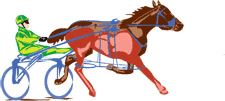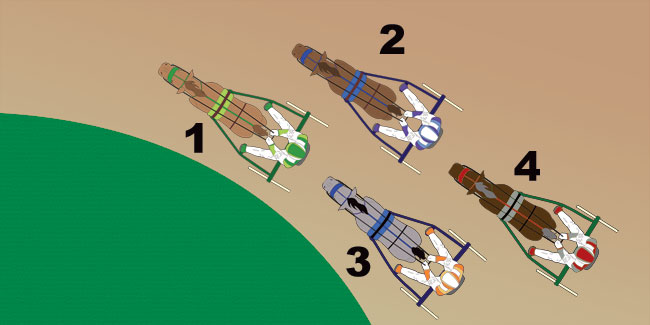There is no better place to find out what harness racing is all about than at the racetrack. Live racing offers pageantry, beauty, drama, and, of course, blazing speed. It takes less than two minutes to convert a first-time visitor into a life-long fan.

There are two main areas for harness fans to watch the races: the grandstand and the clubhouse. The grandstand offers general admission, stadium-style seating, with "ballpark" food available nearby, while the clubhouse offers a more elegant experience with restaurant-quality food. When you walk into the clubhouse or grandstand, you will see televisions all around. These TVs are simulcasting, or broadcasting, races from racetracks all over the world to give the bettors more wagering options from which to choose. Many racetracks also offer slot machines or video lottery terminals for their patrons to enjoy. These hybrid tracks are called "racinos". Revenues from alternative gaming boosts harness racing by raising the purses, or the amount of money for which the horses race.
There are usually between 10 and 15 races on any given night and there is about 20 minutes between each race. This break allows horses to warm up on the track for later races and gives bettors a chance to study the racing program and make their wagers.
Before the race starts, the horses are introduced on the track by the announcer in the post parade.
After the post parade, the starting gate (the car or truck with "wings" on it) leads the horses to the starting line. Harness races are almost always one mile in length and most are finished in less than two minutes. After the race, the winning horse and driver return to the winner's circle to get their picture taken with the winning owner, trainer and other connections.
Harness races are divided into two gaits: pacers and trotters. Horses in each race are all racing on the same gait.
 When pacers race, the legs on the same side of their body move in unison. They can also be identified by their hobbles, which are the loops connecting parallel legs that help them maintain their gait. A horse that can't maintain its gait goes "off-stride", which means it starts to gallop and must move out of the way and lose ground until it can recover its gait. There will usually be more pacing races than trotting races during a race card, and pacers tend to go faster.
When pacers race, the legs on the same side of their body move in unison. They can also be identified by their hobbles, which are the loops connecting parallel legs that help them maintain their gait. A horse that can't maintain its gait goes "off-stride", which means it starts to gallop and must move out of the way and lose ground until it can recover its gait. There will usually be more pacing races than trotting races during a race card, and pacers tend to go faster.
 With trotters, the diagonal legs move in unison. The trotting gait is more natural for the horse, so most do
not need equipment to help them trot, although some wear loops on their front legs to maintain their rhythm, called trotting hobbles. The horses you see on the track have been bred to perform at their particular gait. While some may be able to switch gaits, most race at the same gait as the generations before them. Also, the special shoes and equipment they wear helps them maintain that particular gait.
With trotters, the diagonal legs move in unison. The trotting gait is more natural for the horse, so most do
not need equipment to help them trot, although some wear loops on their front legs to maintain their rhythm, called trotting hobbles. The horses you see on the track have been bred to perform at their particular gait. While some may be able to switch gaits, most race at the same gait as the generations before them. Also, the special shoes and equipment they wear helps them maintain that particular gait.
Since the horses are pulling racebikes with drivers, positioning on the racetrack is of the utmost importance in order to get to the finish line first. Here are some terms that you might hear the announcer say during the race.
The horse in the lead (1) is in a good spot, but has to cut the mile and has no cover.
The horse on the outside (2) is parked and first-over, and has to cover more ground than the horse in the lead.
The horse behind the leader on the rail (3) is in the pocket and enjoys both the shortest distance to the finish and a horse in front to take the wind, but is boxed in and may not find room to advance.
The horse behind the first-over horse (4) is second-over and is arguably in the best position to win. He has cover and can tip out three-wide to sweep to the lead and the win.
